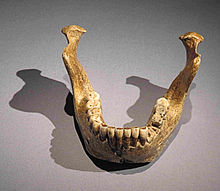
Back Homo heidelbergensis Afrikaans إنسان هايدلبيرغ Arabic Homo heidelbergensis AST Homo heidelbergensis Azerbaijani هایدلبرق اینسانی AZB Heidlbeag-Mensch BAR Гейдэльбергскі чалавек Byelorussian Хайделбергски човек Bulgarian Homo heidelbergensis Breton Homo heidelbergensis Catalan
| Homo heidelbergensis Temporal range: Middle Pleistocene
| |
|---|---|

| |
| The type specimen Mauer 1 | |
| Scientific classification | |
| Domain: | Eukaryota |
| Kingdom: | Animalia |
| Phylum: | Chordata |
| Class: | Mammalia |
| Order: | Primates |
| Suborder: | Haplorhini |
| Infraorder: | Simiiformes |
| Family: | Hominidae |
| Subfamily: | Homininae |
| Tribe: | Hominini |
| Genus: | Homo |
| Species: | †H. heidelbergensis
|
| Binomial name | |
| †Homo heidelbergensis Schoetensack, 1908
| |
| Synonyms | |
| |
Homo heidelbergensis (also H. erectus heidelbergensis,[1] H. sapiens heidelbergensis[2]) is an extinct species or subspecies of archaic human which existed during the Middle Pleistocene. It was subsumed as a subspecies of H. erectus in 1950 as H. e. heidelbergensis, but towards the end of the century, it was more widely classified as its own species. It is debated whether or not to constrain H. heidelbergensis to only Europe or to also include African and Asian specimens, and this is further confounded by the type specimen (Mauer 1) being a jawbone, because jawbones feature few diagnostic traits and are generally missing among Middle Pleistocene specimens. Thus, it is debated if some of these specimens could be split off into their own species or a subspecies of H. erectus. Because the classification is so disputed, the Middle Pleistocene is often called the "muddle in the middle".
H. heidelbergensis is regarded as a chronospecies, evolving from an African form of H. erectus (sometimes called H. ergaster). By convention, H. heidelbergensis is placed as the most recent common ancestor between modern humans (H. sapiens or H. s. sapiens) and Neanderthals (H. neanderthalensis or H. s. neanderthalensis). Many specimens assigned to H. heidelbergensis likely existed well after the modern human/Neanderthal split. In the Middle Pleistocene, brain size averaged about 1,200 cubic centimetres (cc), comparable to modern humans. Height in the Middle Pleistocene can only be estimated based upon remains from three localities: Sima de los Huesos, Spain, 169.5 cm (5 ft 7 in) for males and 157.7 cm (5 ft 2 in) for females; 165 cm (5 ft 5 in) for a female from Jinniushan, China; and 181.2 cm (5 ft 11 in) for a specimen from Kabwe, Zambia; around the same as modern humans. Like Neanderthals, they had wide chests and were robust overall.
The Middle Pleistocene of Africa and Europe features the advent of Late Acheulian technology, diverging from that of earlier and contemporary H. erectus, and probably issuing from increasing intelligence. Fire likely became an integral part of daily life after 400,000 years ago, and this roughly coincides with more permanent and widespread occupation of Europe (above 45°N), and the appearance of hafting technology to create spears.[3] H. heidelbergensis may have been able to carry out coordinated hunting strategies, and consequently they seem to have had a higher dependence on meat.
- ^ e.g. Theodor C. H. Cole, Wörterbuch der Tiernamen: Latein-Deutsch-Englisch / Deutsch-Latein-Englisch, 2nd ed., Spinger: Heidelberg, 2015, p. 210: „Homo heidelbergensis (Homo erectus heidelbergensis) Heidelbergmensch Heidelberg man“; Manfred Eichhorn (ed.), Langenscheidt Routledge: German Dictionary of Biology / Wörterbuch Biologie Englisch: Volume/Band 2: English-German / Englisch-Deutsch, 2nd ed., Langenscheidt: Berlin / Routledge: London & New York, 1999, p. 373: „Heidelberg man (Evol) Homo erectus heidelbergensis, Heidelbergmensch m“
- ^ "Prehistoric Cultures. Homo sapiens heidelbergensis". University of Minnesota Duluth. 2016-12-02. Retrieved 2023-09-23.
- ^ Introduction to Anthropology (1st ed.). openstax (published 2022). 2023. p. 153. ISBN 978-1-951693-99-2.
© MMXXIII Rich X Search. We shall prevail. All rights reserved. Rich X Search